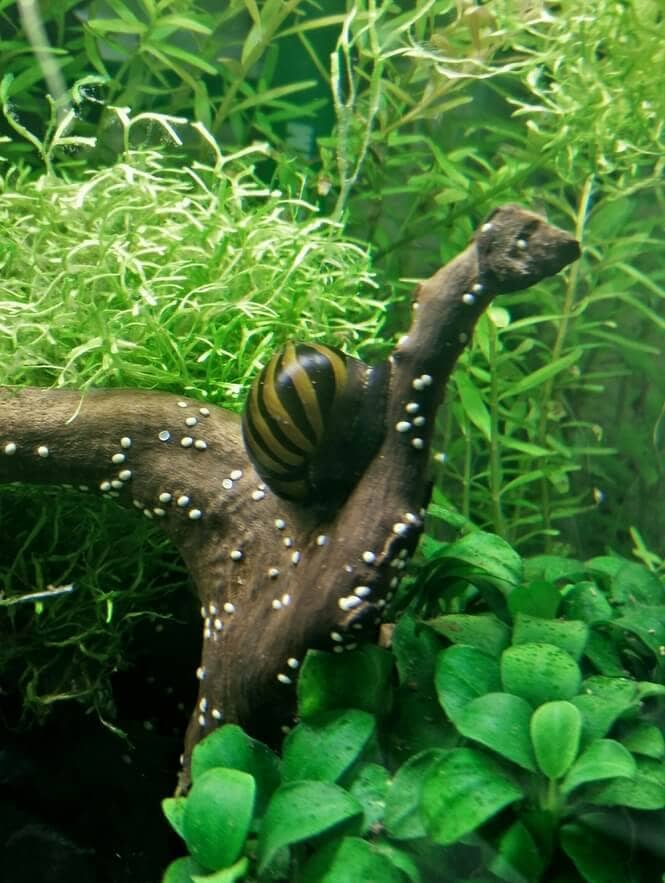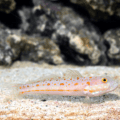Taking care of Nerite snails might be a piece of cake when it comes to their well-being, but do you know what to do with all the tiny white dots that suddenly cover the whole fish tank?

The Nerite snail eggs will keep multiplying and spoiling the inner aesthetics of the aquarium, so you’ll need to find an efficient way for their removal.
Nerite snails are quite adaptive, as they can live and lay eggs in both saline and fresh water. However, the eggs will rarely hatch in freshwater because that’s not the natural reproductive cycle of this type of snail. Nerite larvae prefer brackish water to develop beyond the egg phase and hatch.
Occasionally though, the eggs may hatch in freshwater, but the larvae won’t survive.
A female Nerite snail will keep laying eggs in a freshwater aquarium and they will, in most cases, remain unhatched. From my experience, however, there are several effective methods to deal with this kind of situation.
What to do about unhatched Nerite Snail eggs?
The eggs of a Nerite snail appear as small white ovals and resemble sesame seeds in looks. Technically speaking, these white bumps are not the actual eggs of the snail, but rather tiny capsules that usually hold between 30 and 100 of the actual eggs.

Here’s what the eggs of a Nerite snail look like:
By adequatepotato
Unlike Mystery snail eggs, the egg capsules of Nerite snails will be scattered all over your tank, and especially on driftwood.
Unfortunately, there’s no known creature that would eat the eggs of a Nerite snail. That being said, to get rid of the unhatched nerite snail eggs you can try the following:
1. Interchange the female snails with male ones.

By Ross Engbritson
The majority of freshwater snails are hermaphrodite, which means that they will reproduce asexually.
This is the reason most freshwater aquariums get infested with hundreds of snails when an uninvited hitchhiker ends up in the fish tank.
However, asexual reproduction does not apply to Nerite snails.
These types of snails have distinctive males and females, and breeding includes both genders. The female Nerite lays eggs, which need to be fertilized by a male thereafter.
You can, therefore, remove the females and only leave males in the fish tank.

When it comes to telling the differences between male and female Nerite snails, you’ll need to closely inspect the base of their right eye antenna. The males will have a skin fold at the base of their right eye. The females will lack the fold. Here’s an illustration:
Since spotting the differences may take a long time, I don’t consider it the best method to tell apart Nerite snail genders.
Not all of us have a whole day to stand in front of a fish tank, examining snails with a magnifier.
What worked for me, and I think is the easier way to determine a Nerite snail’s sex, is placing a single one in a 5-gallon bucket and observing if it lays eggs.
It requires some time, but I’ve found it to be a sure way to tell apart the males from the females.
I use the bucket as a “quarantine tank” for new Nerite snails.
If it turns out that a newcomer is a female, I return it and get another one.
Note that for this way of selection to work the Nerite snail must be sexually mature or at least 1 year old.
2. Scrub the eggs with a razor blade.

By Jay_S
You can mechanically scrub the eggs of a Nerite snail by using some sort of tool. To mechanically remove Nerite snail eggs, follow these steps:
- Find a NEW stainless steel razor blade.
- Carefully scrape the eggs from surfaces with the razor blade.
- Collect the fallen eggs with a stainless steel spoon and remove them from the tank.
Make sure you are using a new, unused razor blade.
Also, apply moderate pressure when scraping the eggs, because based on my experience, removal can be somewhat difficult.
I find using a spoon the best way to collect fallen eggs.
It’s important that both tools are made of stainless steel as that’s an aquarium-safe material. Another method I’ve seen success with is by using a sharp algae scraper like this one or something similar.
You can also use a toothbrush, a toothpick, or any sharp tool that you think may work best for you.
Just be careful with the eggs on driftwood, because each removed egg will leave an oval trace.
In my experience, it’s nearly impossible to remove a Nerite’s eggs from driftwood without taking off some of the outer layer of wood.
3. Remove the Nerite snails from the fish tank altogether.

By shannon767
At one point, you may simply lose your motivation to keep trying different tricks for snail egg removal.
In such cases, you can just get rid of all the Nerite snails altogether. Here are a couple of ideas on how to do that:
- Get some fish that are known for eating aquatic snails.
These can include clown loaches, Betta fish, or Pictus catfish.
However, I would not recommend getting a fish just for the sake of removing snails.
Do your research on snail-eating fish and make sure to supplement their diet as necessary.
- Use chemicals, such as copper sulfate.
Frankly, I do not recommend this option, because copper is highly toxic to not only the Nerite snails but all the invertebrates, including shrimp.
Some of your more fragile aquarium plants may also get affected.
If you still want to go ahead with this method, then you need to be very precise with following the instructions on how to use the copper sulfate.
A fish-safe dose of copper sulfate in a freshwater aquarium is in the range of between 0.15 and 0.2 mg/L.
Take into consideration the temperature of the aquarium water and its pH.
As water temperature increases, so does the toxicity, but the right dosage for certain water temperatures will be mentioned on the label of the medicine.
Also, if your water is softer, using copper may turn into a hazardous game for your pet fish.
- Put the Nerite snails into a separate freshwater aquarium.
Or simply return them to the pet shop.
The female Nerite snails will keep laying eggs everywhere, as this is what they usually do.
How to hatch the eggs of a Nerite snail?
There are over 200 Nerite snail types and not all of them are fully researched when it comes to hatching.
Luckily, the majority of Nerite snails sold in pet shops are well-known to science.
If you are interested in seeing your Nerite eggs developing into fully-grown snails, there are some steps to be followed.
That being said, here’s how to hatch the eggs of Nerite snails:
- Set up a separate aquarium with brackish water.
- Put a couple of snails in the new tank. Putting between 5 and 7 will likely be enough to make sure there are males and females.
- Return the mature snail parents back to your freshwater aquarium after the larvae have hatched.
- Feed the babies around 2 to 3 times per day if there are no algae in the aquarium. You can use spirulina powder or phytoplankton to feed the Nerite larvae.
- After 30 days place the grown-up larvae into your freshwater fish tank.
Make sure you use marine salt (do not mistake it for aquarium salt) when preparing the brackish water.
Suggested Read: Ideas for Brackish Aquarium Fish
Anyway, use a hydrometer to test the salinity and stop adding salt when the reading (SG or Specific Gravity) shows anything between 1.002 – 1.005.
Depending on the salinity the eggs will hatch after 20 to 25 days. The temperature should be kept between 79 and 85 °F (26.1 to 29.4 °C).
Alternatively, for step 2, instead of adding the snails to the brackish water, you can move the egg-covered decorations, as they are likely fertilized by the male Nerite snails in the main tank.
This is a preventive measure because once the baby snails are hatched, they will be really tiny and may get sucked by the water filter.
Wait about 3 to 4 weeks for the larvae to become bigger and place them into your original freshwater aquarium.
Avoid having aggressive and carnivorous fish in the freshwater tank, as the small baby snails can easily become prey.
How to Reduce the Number of Eggs Your Nerite Snails Lay?
Even though there are several ways you can deal with the constant laying of eggs by your nerite snails, doing so can certainly be a nuisance.
Fortunately, there are other ways in which you can keep the number of the eggs fairly low.
Here’s how to decrease the number of nerite snail eggs in your tank:
- Don’t overfeed.
Overfeeding is one of the main reasons that lead to an increase in the number of nerite snail eggs.
Therefore, rationing their food so they don’t eat more than they need to will decrease the number of eggs they lay.
Pay attention to how much food is left uneaten when you offer and adjust the portions accordingly.
- Increase water temperature.
Increasing water temperature can reduce the number of eggs since nerite snails typically spawn at colder temperatures.
You should be able to see a decrease in the number of eggs when you increase the temperature by a few degrees.
If you resort to this method, be sure that the other desinens in the fish tank can handle the temperature change.
Lowering the temperature should be gradual or you risk stressing everyone in the aquarium system, including beneficial bacteria.
- Remember to keep the aquarium clean.
Nerite snails kind of thrive in what we call a dirty tank.
To them this dirty environment is actually a feast and an ideal breeding ground.
Keeping the tank clean will negate this effect and your Nerite snails won’t be as eager to lay too many eggs.
My Conclusion
The constant influx of eggs the Nerite snails produce can definitely be bothersome.
In my experience, the most efficient way to benefit from having this snail species is to take time to identify and separate the males from the females.
This is probably the way I’d go about it if I were facing the issue right now.
It may be time-consuming but once you get rid of the female the issue with the eggs will be resolved.
What did you end up doing? What tools did you use to scrape the eggs?
Tell me your story in the comment section below.











I have a new aquarium and I have 6 nerite zebra snail. The snails have started to lay eggs. Would they lay eggs for ever and would the eggs hatch and survive a tropical tank?
Can anyone help I have a large pest snail problem and have got a new tank I have moved my fish over but I’m not sure if I should move my Zebra snails over could these have pest snail eggs on them
So I started a freshwater tank in march and picked up snails from a chain. Then in April, we picked up a few plants at a local shop. While we were waiting on the right time to get fish, suddenly I have baby snails everywhere. We are going on 2 months old I think at this point. We bought a black racer and two smaller nerites. The small black snail has white rings and some eggs along with the rock that is in there. Are they seriously going to die? How long will they survive and how often will they hatch?
It should really be mentioned that any chemicals with copper WILL KILL amphibians, or at least African Dwarf Frogs, anyways. Great article other wise 🙂
I have had a fully stocked 20 gallon for 3 years. I had one Nerite snail for algae help and she was definitely female! Eggs everywhere. I read they wouldn’t hatch in the freshwater tank, so took her out and started the clean-up process. Even after heavy scraping, the ovals still appeared on driftwood and decor. I took all that had visible signs of eggs out and dried it. None hatched, snails gone. Until today. I now have a beautiful 65 gallon setup and us the 20 as a hospital tank. I had two Congo Tetras become listless so I moved them to the 20 and added (aquarium) salt by recommendation of my lfs. Now there are a dozen tiny snails sliming around. Could they have been waiting for some salt, ANY salt, to hatch?
Yes, that’s precisely it.
Some hatch in freshwater but don’t survive. However, brackish water brings them out healthy and ready to roll.
The mess they make is not worth the effort, IMO. But, the snail is just doing what comes naturally. It didn’t anticipate being in your tank. Put them in a quarantine tank or fish bowl without driftwood or decorations that you care about and let them live out their lives in peace. Sure, you can freeze them and toss them out or hit them with a hammer (I so wanted to do this) but that’s not my recommendation.
@pinballer3 I agree with you. Remove to their own tank and let them live in peace. I just started to notice a few egg on the driftwood this morning. Nerites are gonna Nerite. Let ’em be.
With all the non-native species being introduced into the water systems, how do you responsibly dispose of the eggs?
I actually only purchased 1 nerite snail and now have 3 mystery babies 🙂
Hi,
You can freeze them in a small ziplock bag and throw them in the trash bin.
Sad….just sad. How about returning them to the pet store!?
Hi.
Did you bother reading what Karen and I are actually talking about? It’s about the disposal of the unhatched eggs, not the live snails.
That goes for pinballer3 who apparently also misunderstood the whole conversation.
Believe it or not, this IS the responsible way to get rid of the eggs of a species that might potentially turn out to be invasive to your local ecosystem…
Regards,
Momchil
I don’t let my pest snails into the water supply. The Mystery snails I got at a chain store have caused me no end of problems. I make sure I kill them, the eggs are taken out with a paper towel and dried. About y months of manual removals and still working on it. I just want my red racer snails.
I have been breeding nerite snails for more than a year. In my experience, they will hatch in freshwater but they won’t live beyond the stage when you are just beginning to see antennae (several months). Compared to most snails, nerites develop very slowly so I do not agree with the article that says after a couple of weeks you can put the nerites babies back in the freshwater tank. I’m just beginning to start the transfer after nine months. My baby nerites are just starting to look like snails instead of a dot of white, black, brown, clear, green, etc. It will be exciting to see what I end up with because I got some random baby snails when I got plants six months ago. I think I have some pagodas and unfortunately, I found some assassin snails. I’m trying to throw those back into my freshwater tank as quick as possible. Breeding nerites snails in my experience is a labor of love because the babies do not develop quickly like other snail babies do e.g. mystery, pond, ramshorn, etc. Happy fish keeping!!
Hi, Sarey,
Thanks for the input, I will edit the article to reflect your experience as a breeder. I haven’t personally bred them but I did tons of research on the subject. I did not found information that explicitly stated you can’t move them in the larval stage. May I ask for your sources? Thanks in advance!
Anyhow, I have personal experience with my Nerite snail eggs hatching in freshwater. I do mention at the beginning of the article that the babies will occasionally hatch in freshwater but won’t grow (right in the intro).
Also, there are a lot of Nerite snail species and they do range from brackish to full-blown saltwater. During my research, I stumbled upon someone who increased their success rate by more than 50% by just increasing the salinity in the tank (going way beyond what is considered “brackish salinity”). Obviously, they were breeding a species that needs more salinity for the eggs to develop and hatch.
If I may ask – how many Nerita “breeding projects” have you had for the 1+ year you’ve been breeding them. You mention 9 months before transition, and I’m sure the acclimatization took some time too. Could it be a single project or you have a constant supply of Nerite snail eggs that you hatch and look after on a continuous basis? My point is your experience may not be universal if it was just one “batch”.
Evidently, you’ve bred more Nerite snails than me, so there’s that…
Thanks for your input!
We’ve had two nerite snails in our aquarium since September and just started seeing eggs last week. This week some of the eggs started to have what looked like a dark spot inside, but now it looks more like they are hollow. Does this mean those eggs are dead?
Hi,
Most likely the eggs are dead, yes. Even if they do hatch, the larvae won’t survive in a freshwater aquarium. You can remove them right away, if that’s what you’re asking.
Good luck!
Best,
Momchil
Well I ended up here because I just noticed snail eggs for the first time. Of course, they’re all over the driftwood. 🙄
I can put up with them for now but if they spread any more I guess I’ll be spending some time scraping them off. I’ve only got 2 snails and they do a good job on the algae so I’m loathe to remove them. I supplemented their diet with some zucchini for the first time recently and suddenly the eggs appear, I wonder if there is any connection? Anyway, informative article, thanks for posting it!
Hi Kas,
I wouldn’t think there’s a connection. Nerite snails will always lay eggs in the conditions a typical home aquarium provides.
Good luck with your eggs!
Best,
Momchil